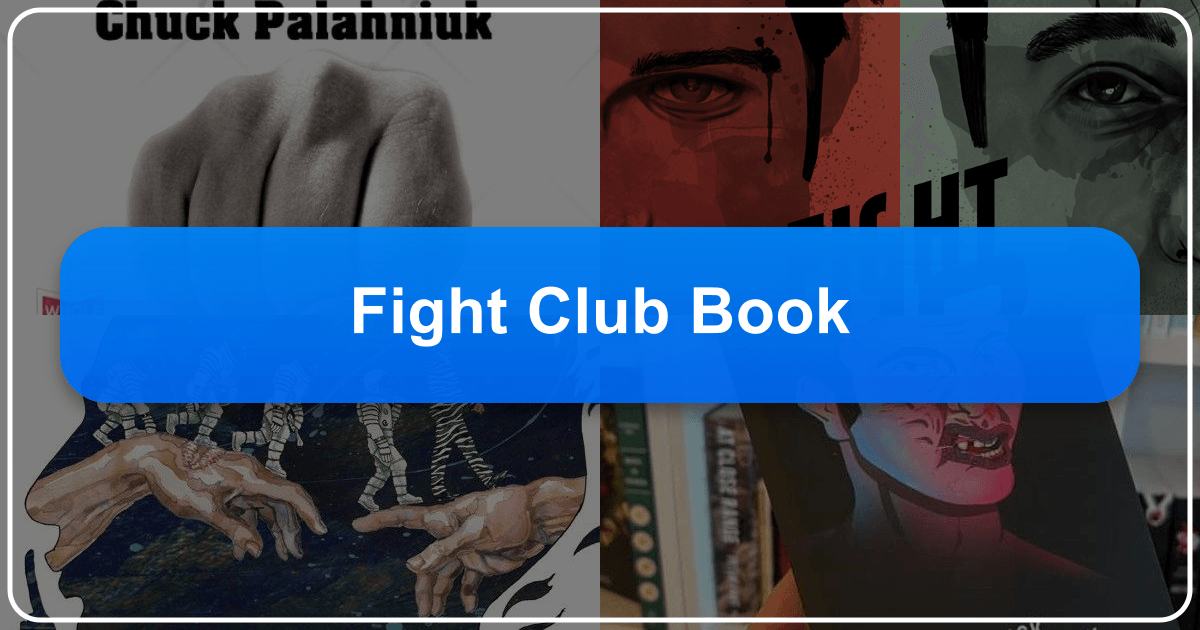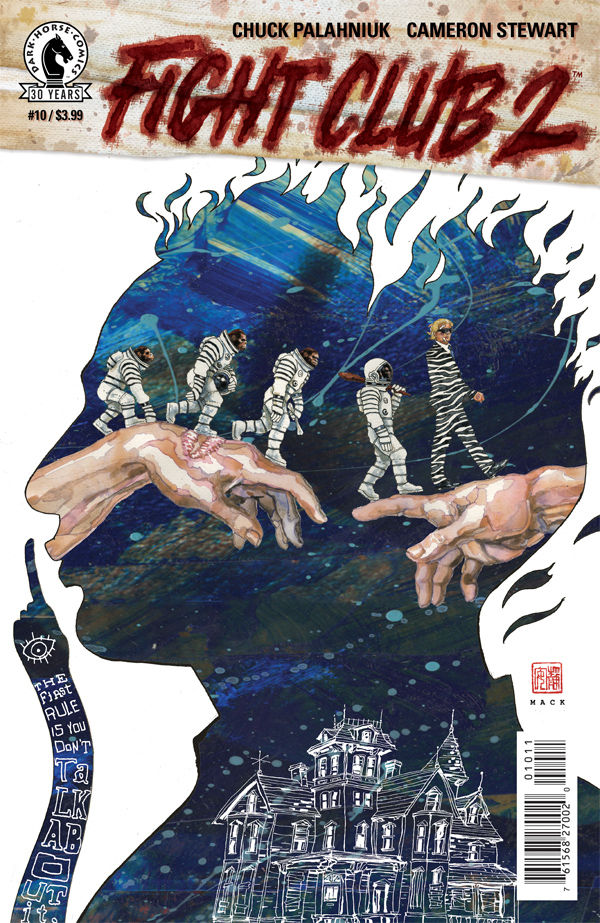*Fight Club* Book: A Deep Dive into Palahniuk's Provocative Novel

Chuck Palahniuk’s Fight Club isn’t just a novel; it’s a cultural phenomenon. Published in 1996, it captured the disillusionment of a generation and sparked a debate about masculinity, consumerism, and the search for meaning in a seemingly meaningless world. This in-depth analysis will explore Fight Club through various lenses, examining its genre, authorial style, cultural impact, and the lasting lessons it offers readers.
Genre and Literary Context
Fight Club defies easy categorization. While often labeled as a thriller or dark satire, its blend of genres makes it a unique and challenging read. It incorporates elements of:
-
Thriller: The suspenseful narrative, unreliable narrator, and escalating violence create a thrilling experience for the reader. The mystery surrounding Tyler Durden and the ultimate revelation of his identity keeps the reader engaged.
-
Dark Satire: Palahniuk masterfully satirizes consumerism, societal expectations, and the emptiness of modern life. The absurdity of the fight club and Project Mayhem serves as a commentary on the flaws of contemporary society.
-
Psychological Fiction: The novel delves into the psyche of its unnamed narrator, exploring themes of identity, alienation, and mental instability. The narrator’s fractured personality and unreliable perspective make for a psychologically complex narrative.
-
Men’s Fiction: While not exclusively a “men’s fiction” novel, it certainly focuses on the experiences and struggles of men in a patriarchal society. The themes of masculinity, emotional repression, and the lack of male role models resonate deeply with many male readers. However, its critique of toxic masculinity also provides valuable insights for female readers.
Ruzmari’s Goodreads review aptly places Fight Club within the context of 1990s literature, noting the dichotomy between “chick lit” and “guy crap.” Fight Club falls into the latter category, yet it transcends simple genre labels due to its complex and layered approach. The unrelenting “GUY-ness” of the narrative, as Ruzmari points out, is both a strength and a potential weakness. It may initially draw in readers with its aggressive style, but its relentless intensity can be exhausting for some.
Chuck Palahniuk: Authorial Style and Inspirations

Palahniuk’s writing style in Fight Club is as unconventional as the novel’s themes. His prose is characterized by:
-
Short, choppy sentences: This stylistic choice reflects the fragmented and chaotic nature of the narrator’s inner world and contributes to the book’s frantic pace. It mimics the rhythm of a fight, quick jabs and hard blows.
-
Repetitive phrasing: The repetition of phrases like “The first rule of Fight Club…” emphasizes the clandestine nature of the organization and enhances the sense of mystery and rebellion.
-
Unreliable narration: The narrator’s lack of self-awareness and his unreliable perspective create a sense of unease and uncertainty. The reader is forced to question everything the narrator says and piece together the truth for themselves.
-
Graphic violence: Palahniuk doesn’t shy away from depicting violence, often in vivid and disturbing detail. This serves to shock the reader and confront them with the darker aspects of human nature.
-
Dark humor: The novel is laced with dark humor that underscores the absurdity of the situations and comments on the desperation of the characters. This humor isn’t lighthearted; it’s a grim and unsettling sort that serves to emphasize the novel’s thematic concerns.
Palahniuk’s work has been compared to authors like Bret Easton Ellis (American Psycho) and Irvine Welsh (Trainspotting) for its unflinching portrayal of violence and societal critique. However, Palahniuk’s style is distinct, with its particular blend of aggression and self-awareness. Some critics have considered it “pretentious,” a point raised in Sarah’s Goodreads review. However, this perceived pretentiousness is often a part of the overall satirical effect, challenging the reader’s expectations and perceptions.
Reading Fight Club: Summaries, Educational Value, and Life Lessons
The novel’s plot revolves around an insomniac narrator who attends support groups for various illnesses to find solace from his boredom and insomnia. He meets Marla Singer, another support group imposter. Later, he encounters Tyler Durden, a charismatic soap maker. Together they start Fight Club, a secret underground organization where men engage in brutal fistfights to confront their feelings of alienation and powerlessness.

Fight Club gradually evolves into Project Mayhem, a far more destructive and anarchic organization. The novel culminates in a dramatic twist that reveals the true nature of Tyler Durden and the narrator’s relationship.
While the acts of violence and destruction might seem alarming, the educational value of Fight Club lies in its unflinching exploration of significant themes:
-
Consumerism: The novel critiques the destructive nature of consumerism and its effect on identity. The narrator’s apartment full of Ikea furniture represents this critique effectively, highlighting how material possessions can fill a void but fail to generate true happiness.
-
Masculinity: The novel examines traditional notions of masculinity and challenges toxic behaviors. The fight club initially seems like a release for men’s repressed emotions, but it ultimately becomes a destructive force.
-
Alienation: The novel powerfully portrays the sense of alienation and isolation experienced by many individuals in modern society. The characters’ struggles with their jobs and relationships reveal the lack of genuine human connection in contemporary life.
-
Mental Health: The narrator’s struggles with insomnia and his multiple personality disorder highlight the importance of mental well-being. This is a subtle yet powerful theme, illustrating how mental health can significantly influence an individual’s actions and perceptions of reality.
The novel’s central idea is explored within the narrative itself. The disaffected youth of the video game generation, according to the book’s narrative, hold the truth about society; society is merely a reflection of this disaffected worldview; and the disaffected always remain disaffected. There is no improvement, connection, healing, or escape, because boys never mature. This assertion, which forms the story’s core, is something to be questioned.
The life lessons from Fight Club are complex and multifaceted. It’s not a prescriptive guide, rather a compelling exploration of challenging issues. It invites readers to confront their own feelings of alienation, question societal norms, and find a sense of meaning in their lives outside of the limitations of consumer culture and toxic masculinity.

Libraries and Archives: Preserving Fight Club’s Legacy
Fight Club, as a significant piece of contemporary literature, has earned its place in numerous libraries and archives. Its presence in both physical and digital libraries ensures its accessibility to future generations of readers. The book’s inclusion in rare collections and archives highlights its status as a cultural artifact. Further, its impact extends beyond the realm of libraries and archives; the novel’s persistent online presence is visible across numerous websites, forums, and social media platforms. These digital archives and fan communities contribute to the ongoing conversation around its themes and significance.
Cultural Impact and Adaptations
Fight Club’s impact extends far beyond the literary world. Its cultural influence is undeniable:
-
Film Adaptation: David Fincher’s 1999 film adaptation is considered a cult classic, further popularizing the novel’s themes and aesthetic. Although the film’s ending differs from the book, the movie successfully captured the essence of Palahniuk’s work.
-
Literary Influence: The novel’s influence on subsequent literature is evident in the rise of similar works that explore themes of alienation, masculinity, and consumerism. It has inspired authors to explore these complex themes in bold and unconventional ways.
-
Awards: While it did not win many major awards, its recognition, especially the Oregon Book Award for best novel, solidified its standing among contemporary novels.
-
Communities: Fight Club has fostered a significant online community of fans who discuss the book’s themes and symbolism, creating a space for continued engagement with the text.
-
Merchandise: Beyond books and movie versions, Fight Club has also spawned merchandise, including t-shirts, posters, and other paraphernalia, which contributes to its lasting cultural reach.
The film adaptation, in particular, brought the novel’s themes into the mainstream, fueling discussions about its social and psychological commentary. The film’s visual style and use of music further enhanced the story’s impact, making it resonate with a wide audience.
In conclusion, Chuck Palahniuk’s Fight Club remains a compelling and thought-provoking novel that continues to resonate with readers and shape cultural conversations. Its blend of genres, unconventional style, and powerful themes ensure its enduring legacy in literature and beyond. Its exploration of alienation, consumerism, and masculinity is still relevant today, inviting readers to reflect on these persistent societal issues. The debate surrounding its themes, interpretation, and the lasting implications of its cultural phenomenon continue to this day, firmly cementing Fight Club as more than just a novel. It’s a cultural landmark.